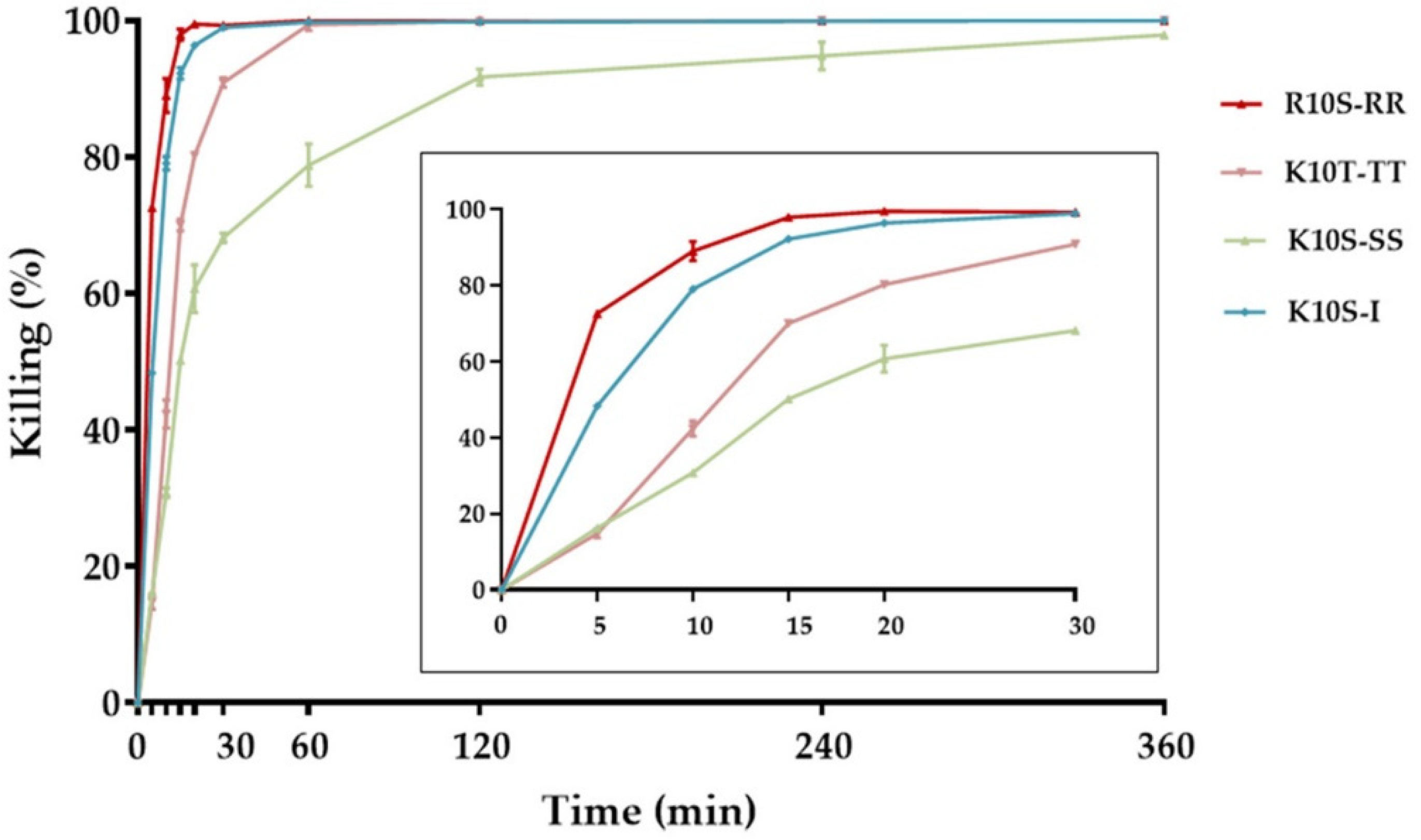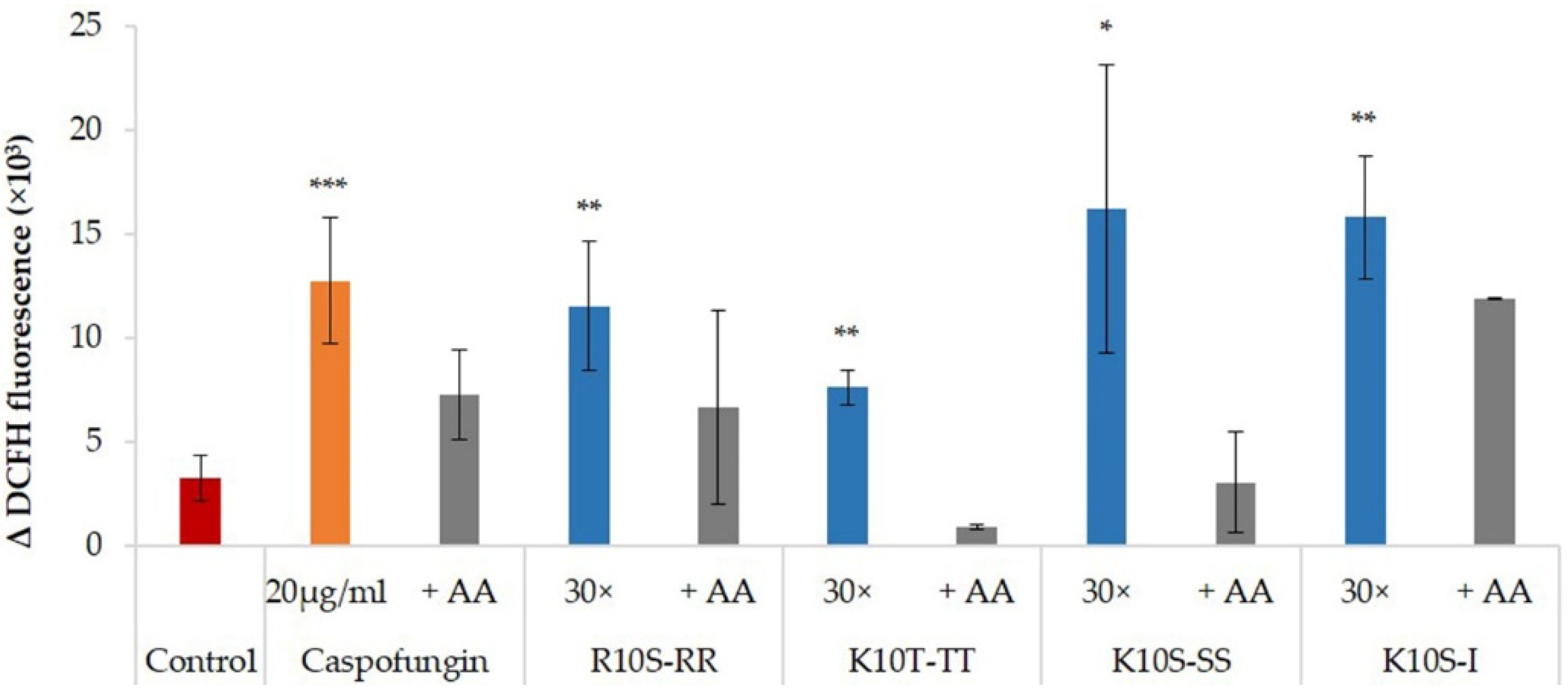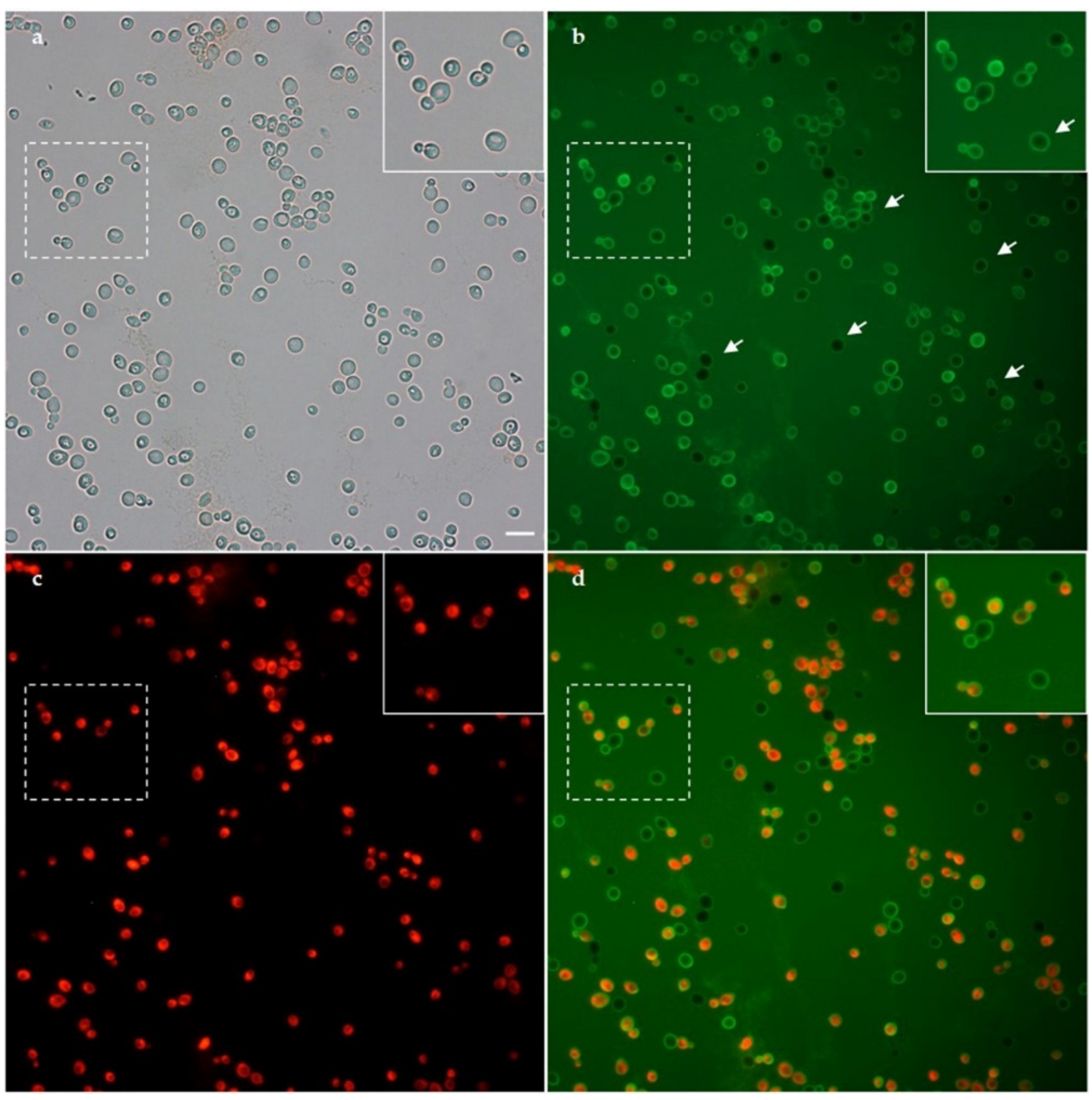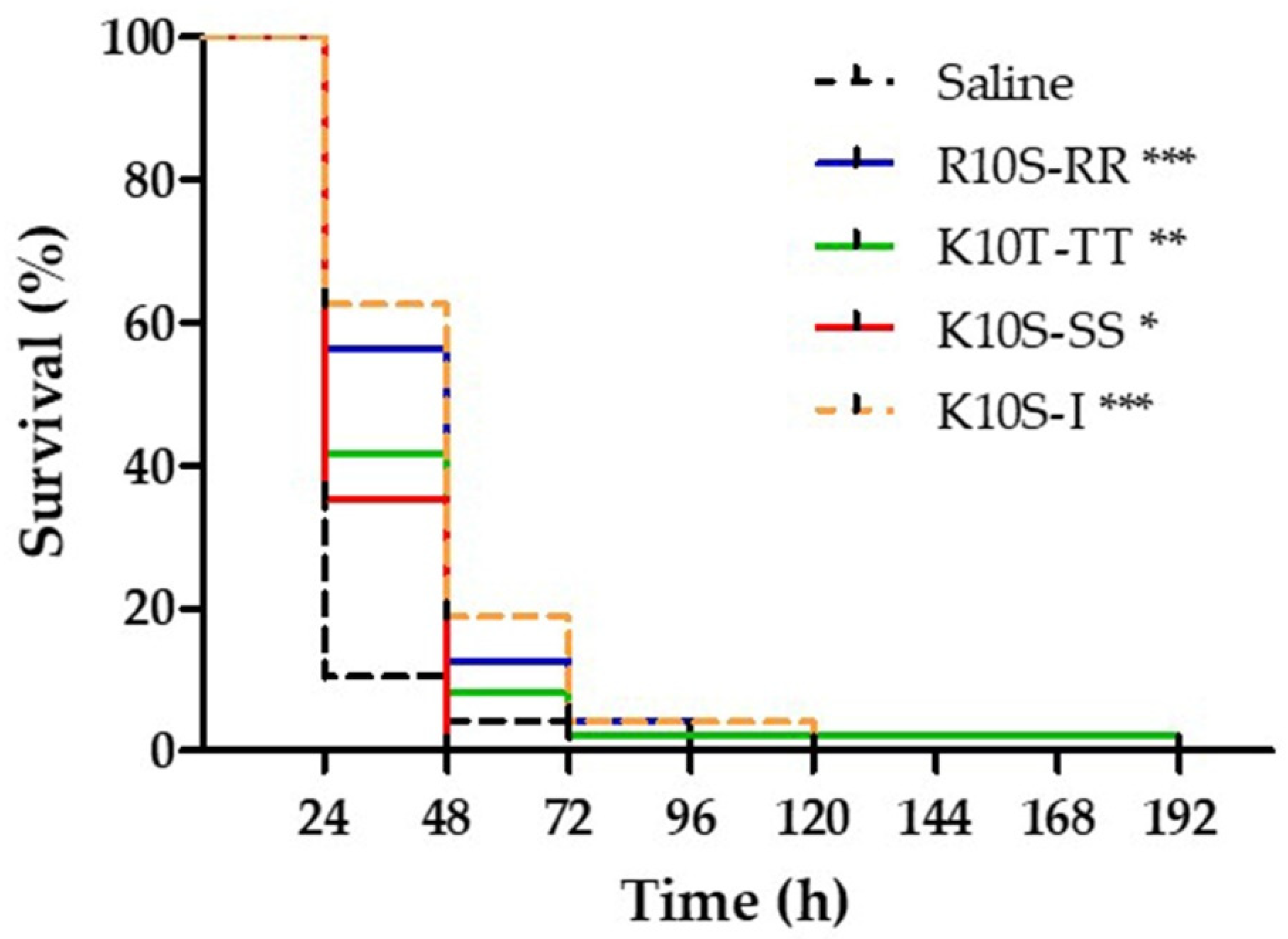In Silico Predicted Antifungal Peptides: In Vitro and In Vivo Anti-Candida Activity
Abstract
1. Introduction
2. Materials and Methods
2.1. In Silico Analysis
2.2. Peptide Synthesis
2.3. Evaluation of the In Vitro Candidacidal Activity of ISDPs
2.4. Evaluation of the Hemolytic and Cytotoxic Effects of ISDPs
2.5. Circular Dichroism (CD) Spectroscopy
2.6. Evaluation of Apoptosis Induction and Reactive Oxygen Species (ROS) Production in C. albicans after Treatment with ISDPs
2.7. Fluorescence Microscopy Studies
2.8. Evaluation of In Vivo Therapeutic Activity of ISDPs in Galleria mellonella
3. Results
3.1. In Silico Peptide Analysis and ISDPs’ Selection
3.2. In Vitro Candidacidal Activity of ISDPs
3.3. Hemolytic and Cytotoxic Effects of ISDPs
3.4. ISDPs Conformational State
3.5. Apoptosis Induction and ROS Production in C. albicans Cells after Treatment with ISDPs
3.6. Fluorescence Microscopy Studies on C. albicans Cells after Treatment with ISDPs
3.7. In Vivo Therapeutic Activity of ISDPs in G. mellonella
4. Discussion
Author Contributions
Funding
Data Availability Statement
Acknowledgments
Conflicts of Interest
References
- World Health Organization. Global Health Estimates 2016: Deaths by Cause, Age, Sex, by Country and by Region, 2000–2016. Geneva. 2018. Available online: https://www.who.int/healthinfo/global_burden_disease/estimates/en/ (accessed on 5 May 2021).
- Bhattacharya, S.; Sae-Tia, S.; Fries, B.C. Candidiasis and Mechanisms of Antifungal Resistance. Antibiotics 2020, 9, 312. [Google Scholar] [CrossRef] [PubMed]
- Beattie, S.R.; Krysan, D.J. Antifungal drug screening: Thinking outside the box to identify novel antifungal scaffolds. Curr. Opin. Microbiol. 2020, 57, 1–6. [Google Scholar] [CrossRef]
- Mani Chandrika, K.V.S.; Sharma, S. Promising antifungal agents: A minireview. Bioorg. Med. Chem. 2020, 28, 115398. [Google Scholar] [CrossRef]
- McEvoy, K.; Normile, T.G.; Poeta, M.D. Antifungal Drug Development: Targeting the Fungal Sphingolipid Pathway. J. Fungi 2020, 6, 142. [Google Scholar] [CrossRef]
- Houšť, J.; Spížek, J.; Havlíček, V. Antifungal Drugs. Metabolites 2020, 10, 106. [Google Scholar] [CrossRef]
- Gintjee, T.J.; Donnelley, M.A.; Thompson, G.R., 3rd. Aspiring Antifungals: Review of Current Antifungal Pipeline Developments. J. Fungi 2020, 6, 28. [Google Scholar] [CrossRef]
- Rauseo, A.M.; Coler-Reilly, A.; Larson, L.; Spec, A. Hope on the Horizon: Novel Fungal Treatments in Development. Open Forum Infect. Dis. 2020, 7, ofaa016. [Google Scholar] [CrossRef]
- Van Daele, R.; Spriet, I.; Wauters, J.; Maertens, J.; Mercier, T.; Van Hecke, S.; Brüggemann, R. Antifungal drugs: What brings the future? Med. Mycol. 2019, 57, S328–S343. [Google Scholar] [CrossRef]
- Ciociola, T.; Giovati, L.; Conti, S.; Magliani, W.; Santinoli, C.; Polonelli, L. Natural and synthetic peptides with antifungal activity. Future Med. Chem. 2016, 8, 1413–1433. [Google Scholar] [CrossRef]
- Roncevic, T.; Puizina, J.; Tossi, A. Antimicrobial Peptides as Anti-Infective Agents in Pre-Post-Antibiotic Era? Int. J. Mol. Sci. 2019, 20, 5713. [Google Scholar] [CrossRef]
- Barbosa, F.; Pinto, E.; Kijjoa, A.; Pinto, M.; Sousa, E. Targeting antimicrobial drug resistance with marine natural products. Int. J. Antimicrob. Agents 2020, 56, 106005. [Google Scholar] [CrossRef]
- Fernández de Ullivarri, M.; Arbulu, S.; Garcia-Gutierrez, E.; Cotter, P.D. Antifungal Peptides as Therapeutic Agents. Front. Cell Infect. Microbiol. 2020, 10, 105. [Google Scholar] [CrossRef] [PubMed]
- Ciociola, T.; Giovati, L.; Conti, S.; Magliani, W. Anti-Infective Antibody-Derived Peptides Active against Endogenous and Exogenous Fungi. Microorganisms 2021, 9, 143. [Google Scholar] [CrossRef] [PubMed]
- Koo, H.B.; Seo, J. Antimicrobial peptides under clinical investigation. Pept. Sci. 2019, 111, e24122. [Google Scholar] [CrossRef]
- Lazzaro, B.P.; Zasloff, M.; Rolff, J. Antimicrobial peptides: Application informed by evolution. Science 2020, 368. [Google Scholar] [CrossRef]
- Agrawal, P.; Bhalla, S.; Chaudhary, K.; Kumar, R.; Sharma, M.; Raghava, G.P.S. In Silico Approach for Prediction of Antifungal Peptides. Front. Microbiol. 2018, 9, 323. [Google Scholar] [CrossRef] [PubMed]
- Liu, X.H.; Zhao, J.F.; Wang, T.; Wu, M.B. Design, identification, antifungal evaluation and molecular modeling of chlorotetaine derivatives as new anti-fungal agents. Nat. Prod. Res. 2020, 34, 1712–1720. [Google Scholar] [CrossRef]
- Ciociola, T.; Pertinhez, T.A.; De Simone, T.; Magliani, W.; Ferrari, E.; Belletti, S.; D’Adda, T.; Conti, S.; Giovati, L. In Vitro and In Vivo Anti-Candida Activity and Structural Analysis of Killer Peptide (KP)-Derivatives. J. Fungi 2021, 7, 129. [Google Scholar] [CrossRef]
- Pertinhez, T.A.; Ciociola, T.; Giovati, L.; Magliani, W.; Belletti, S.; Polonelli, L.; Conti, S.; Spisni, A. Dissection of the Structural Features of a Fungicidal Antibody-Derived Peptide. Int. J. Mol. Sci. 2018, 19, 3792. [Google Scholar] [CrossRef]
- Ciociola, T.; Pertinhez, T.A.; Giovati, L.; Sperinde, M.; Magliani, W.; Ferrari, E.; Gatti, R.; D’Adda, T.; Spisni, A.; Conti, S.; et al. Dissecting the Structure-Function Relationship of a Fungicidal Peptide Derived from the Constant Region of Human Immunoglobulins. Antimicrob. Agents Chemother. 2016, 60, 2435–2442. [Google Scholar] [CrossRef]
- Polonelli, L.; Ciociola, T.; Magliani, W.; Zanello, P.P.; D’Adda, T.; Galati, S.; De Bernardis, F.; Arancia, S.; Gabrielli, E.; Pericolini, E.; et al. Peptides of the constant region of antibodies display fungicidal activity. PLoS ONE 2012, 7, e34105. [Google Scholar] [CrossRef]
- Pourmirjafari Firoozabadi, T.; Shankayi, Z.; Izadi, A.; Pourmirjafari Firoozabadi, S.M. Can Lucifer Yellow Indicate Correct Permeability of Biological Cell Membrane under An Electric and Magnetic Field? Cell J. 2015, 16, 560–563. [Google Scholar] [CrossRef] [PubMed]
- Polonelli, L.; Ciociola, T.; Elviri, L.; Zanello, P.P.; Giovati, L.; Arruda, D.C.; Munoz, J.E.; Mortara, R.A.; Morace, G.; Borghi, E.; et al. A Naturally Occurring Antibody Fragment Neutralizes Infectivity of Diverse Infectious Agents. Sci. Rep. 2016, 6, 35018. [Google Scholar] [CrossRef]
- Brown, G.D.; Denning, D.W.; Gow, N.A.R.; Levitz, S.M.; Netea, M.G.; White, T.C. Hidden killers: Human fungal infections. Sci. Transl. Med. 2012, 4, 165rv113. [Google Scholar] [CrossRef]
- Kang, X.; Dong, F.; Shi, C.; Liu, S.; Sun, J.; Chen, J.; Li, H.; Xu, H.; Lao, X.; Zheng, H. DRAMP 2.0, an updated data repository of antimicrobial peptides. Sci. Data 2019, 6, 148. [Google Scholar] [CrossRef] [PubMed]
- Ghosh, C.; Sarkar, P.; Issa, R.; Haldar, J. Alternatives to Conventional Antibiotics in the Era of Antimicrobial Resistance. Trends Microbiol. 2019, 27, 323–338. [Google Scholar] [CrossRef]
- Basso, V.; Tran, D.Q.; Ouellette, A.J.; Selsted, M.E. Host Defense Peptides as Templates for Antifungal Drug Development. J. Fungi 2020, 6, 241. [Google Scholar] [CrossRef]
- Reis Zambom, C.; Henrique da Fonseca, F.; Santesso Garrido, S. Bio- and Nanotechnology as the Key for Clinical Application of Salivary Peptide Histatin: A Necessary Advance. Microorganisms 2020, 8, 1024. [Google Scholar] [CrossRef]
- Sousa, F.; Ferreira, D.; Reis, S.; Costa, P. Current Insights on Antifungal Therapy: Novel Nanotechnology Approaches for Drug Delivery Systems and New Drugs from Natural Sources. Pharmaceuticals 2020, 13, 248. [Google Scholar] [CrossRef]
- Hao, Y.; Yang, N.; Teng, D.; Wang, X.; Mao, R.; Wang, J. A review of the design and modification of lactoferricins and their derivatives. BioMetals 2018, 31, 331–341. [Google Scholar] [CrossRef]
- Wu, Y.; Huang, R.; Jin, J.-M.; Zhang, L.-J.; Zhang, H.; Chen, H.-Z.; Chen, L.-L.; Luan, X. Advances in the Study of Structural Modification and Biological Activities of Anoplin. Front. Chem. 2020, 8, 519. [Google Scholar] [CrossRef] [PubMed]
- Kang, J.H.; Lee, M.K.; Kim, K.L.; Hahm, K.S. Structure-biological activity relationships of 11-residue highly basic peptide segment of bovine lactoferrin. Int. J. Pept. Protein Res. 1996, 48, 357–363. [Google Scholar] [CrossRef] [PubMed]
- Lum, K.Y.; Tay, S.T.; Le, C.F.; Lee, V.S.; Sabri, N.H.; Velayuthan, R.D.; Hassan, H.; Sekaran, S.D. Activity of Novel Synthetic Peptides against Candida albicans. Sci. Rep. 2015, 5, 9657. [Google Scholar] [CrossRef] [PubMed]
- Levitt, M. Conformational preferences of amino acids in globular proteins. Biochemistry 1978, 17, 4277–4285. [Google Scholar] [CrossRef] [PubMed]
- Kyte, J.; Doolittle, R.F. A simple method for displaying the hydropathic character of a protein. J. Mol. Biol. 1982, 157, 105–132. [Google Scholar] [CrossRef]







| Peptide | Sequence Alignment |
|---|---|
| K10S | -KKVTMTCSAS |
| D5A | TCRVAHRGLTF |
| N1A | -AQVSLTCLVK |
| Peptide | Sequence | Substitution | M.M. (Da) | GRAVY Value | pI | Net Charge |
|---|---|---|---|---|---|---|
| K10S (parent) | KKVTMTCSAS | - | 1055.27 | −0.040 | 9.31 | 2+ |
| R10S-RR | RRVTMTCSAS | Basic | 1111.30 | −0.160 | 10.35 | 2+ |
| K10T-TT | KKVTMTCTAT | Ser/Thr | 1083.33 | −0.020 | 9.31 | 2+ |
| K10S-SS | KKVSMSCSAS | Thr/Ser | 1027.22 | −0.060 | 9.31 | 2+ |
| K10S-I | KKVTMTCSIS | Hydrophobic | 1097.35 | 0.230 | 9.31 | 2+ |
| Peptide | EC50 1 (95% Confidence Intervals) | EC50 ISDP/EC50 K10S |
|---|---|---|
| K10S | 0.277 (0.274–0.279) 2 | - |
| R10S-RR | 0.254 (0.247–0.262) | 0.92 |
| K10T-TT | 0.173 (0.171–0.175) | 0.62 |
| K10S-SS | 0.159 (0.150–0.168) | 0.57 |
| K10S-I | 0.260 (0.239–0.282) | 0.94 |
Publisher’s Note: MDPI stays neutral with regard to jurisdictional claims in published maps and institutional affiliations. |
© 2021 by the authors. Licensee MDPI, Basel, Switzerland. This article is an open access article distributed under the terms and conditions of the Creative Commons Attribution (CC BY) license (https://creativecommons.org/licenses/by/4.0/).
Share and Cite
Ciociola, T.; Magliani, W.; De Simone, T.; Pertinhez, T.A.; Conti, S.; Cozza, G.; Marin, O.; Giovati, L. In Silico Predicted Antifungal Peptides: In Vitro and In Vivo Anti-Candida Activity. J. Fungi 2021, 7, 439. https://doi.org/10.3390/jof7060439
Ciociola T, Magliani W, De Simone T, Pertinhez TA, Conti S, Cozza G, Marin O, Giovati L. In Silico Predicted Antifungal Peptides: In Vitro and In Vivo Anti-Candida Activity. Journal of Fungi. 2021; 7(6):439. https://doi.org/10.3390/jof7060439
Chicago/Turabian StyleCiociola, Tecla, Walter Magliani, Tiziano De Simone, Thelma A. Pertinhez, Stefania Conti, Giorgio Cozza, Oriano Marin, and Laura Giovati. 2021. "In Silico Predicted Antifungal Peptides: In Vitro and In Vivo Anti-Candida Activity" Journal of Fungi 7, no. 6: 439. https://doi.org/10.3390/jof7060439
APA StyleCiociola, T., Magliani, W., De Simone, T., Pertinhez, T. A., Conti, S., Cozza, G., Marin, O., & Giovati, L. (2021). In Silico Predicted Antifungal Peptides: In Vitro and In Vivo Anti-Candida Activity. Journal of Fungi, 7(6), 439. https://doi.org/10.3390/jof7060439











